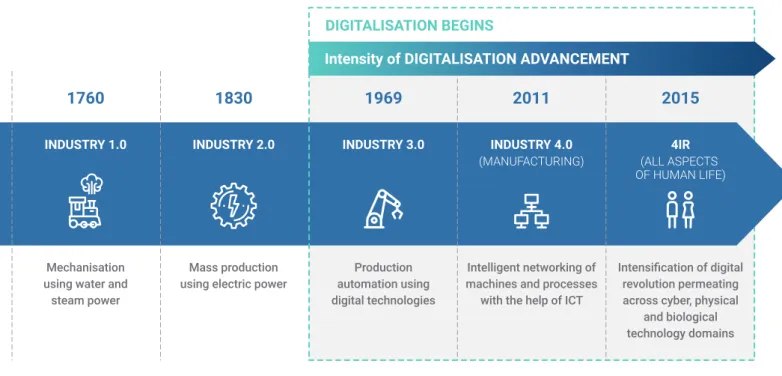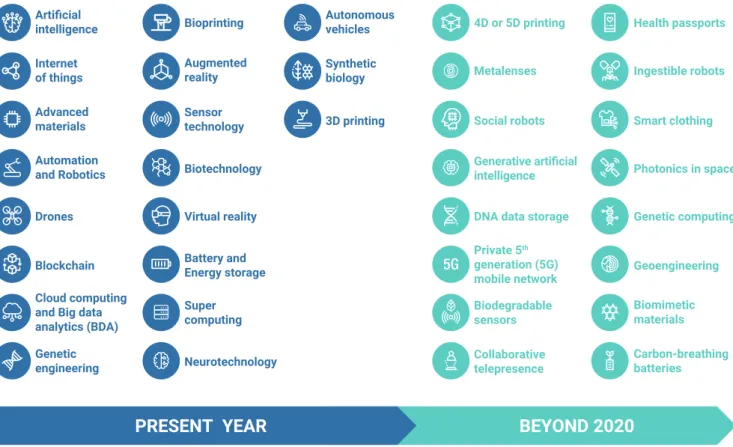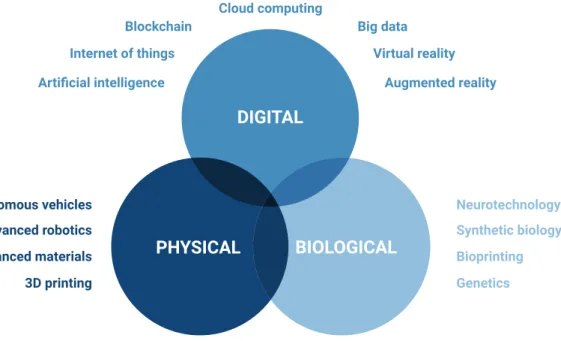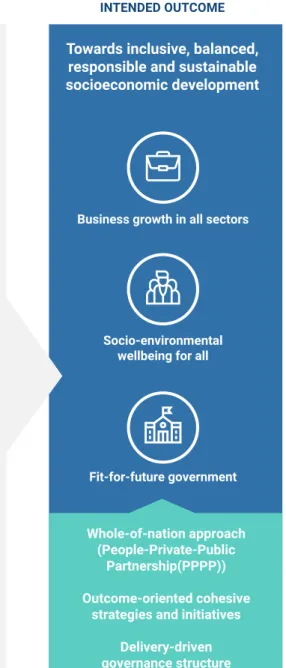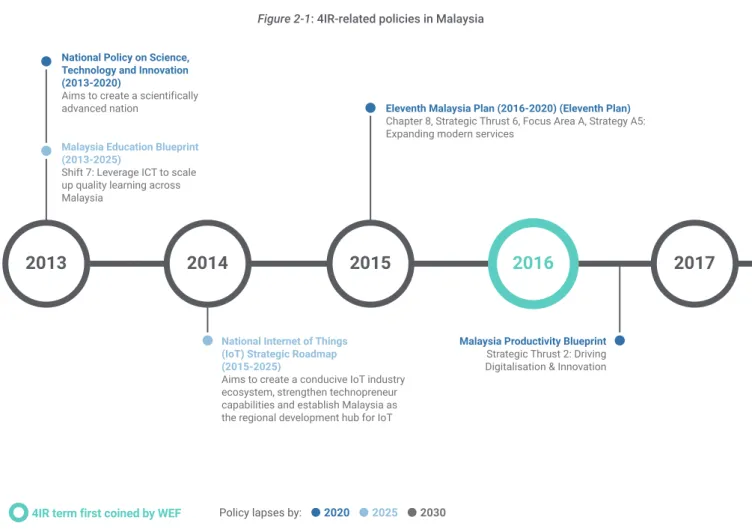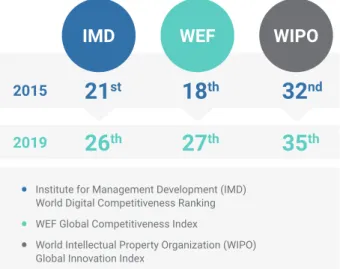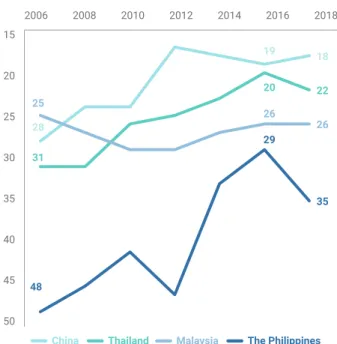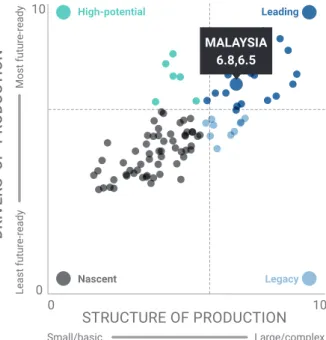The 4IR National Policy is a testament to the government's commitment to making the digital revolution a reality today. The 4IR national policy is coordinated with the national science, technology and innovation policy (DSTIN).
NATIONAL 4IR POLICY: QUICK FACTS
What is National 4IR Policy?
What is the Fourth
Industrial Revolution (4IR)?
Why National 4IR Policy?
QUALITY OF LIFE
LOCAL CAPABILITIES
ECOLOGICAL INTEGRITY
TO ACHIEVE BY 2030
Where are we going – vision and outcomes?
HOW DO WE ACHIEVE THE ASPIRATION OF THE NATIONAL 4IR POLICY?
Whole-of-nation approach – Coherent
Clear policy directions and targeted strategies – The 4IR National Policy outlines 4 policy directions, 16 strategies and 32 national initiatives that set the direction for all ministries and agencies to align their plans around 4IR and emerging technologies. Each policy direction is supported by tailored strategies and initiatives targeting business, society and government, taking into account the interdependence of each group to increase the country's readiness for 4IR.
4 POLICY THRUSTS
SOCIETY BUSINESSES
GOVERNMENT
Five foundational technologies –
Resources will be focused on building technological capabilities in five foundational 4IR technologies, which can support the deployment and optimization of other 4IR technologies. Governance – The national 4IR policy will be governed by the National Digital Economy and the 4IR Council, chaired by the Prime Minister, to optimize the allocation and coordination of resources to increase the country's preparedness for 4IR.
Ten key focus sectors – Deployment of 4IR technologies will be focused on 10 key sectors,
ARTIFICIAL INTELLIGENCE
INTERNET OF THINGS
BLOCKCHAIN
CLOUD COMPUTING AND BIG DATA ANALYTICS
ADVANCED MATERIALS AND TECHNOLOGIES
Sectors focus with potential integration with the global value chain
Sectors supporting socio-economic needs
Sectors that drive technology adoption
Supporting sectors
4IR IN PERSPECTIVE 19 4IR: An inevitable wave of change 20 Impact of 4IR 21 Relationship between 4IR and the digital economy 26. National 4IR Policy Approach 39 Vision for the future 42 The National 4IR Policy Overview 44 Strategic policies and initiatives 48.
CONTENT
4IR IN PERSPECTIVE
4IR is disrupting traditional sectors that include centralized factories, large workforces, and huge corporations. 4IR can potentially improve the welfare of society if directed in the right direction.
4IR is characterised by a fusion of technologies that is blurring
In addition, the speed, breadth and depth of 4IR require the transformation of entire production systems. 4IR can raise income levels, increase community cohesion, improve efficiency, provide convenience and better protect limited natural resources.
4IR: AN INEVITABLE WAVE OF CHANGE
Meanwhile, 70% of the targets in the United Nations (UN) Sustainable Development Goals (SDGs) are achievable using 4IR technology applications. Without appropriate mitigation measures, it can exacerbate social inequalities and wealth disparities, as well as erode trust within society.
BENEFITS AND RISKS
The application of 4IR technologies has great potential economic and social benefits as well as risks, as shown in Figure 1-1.
IMPACT OF 4IR
It represented the use of water and steam power to mechanize production, from hand tools to machine tools. This was replaced by industry where many industries began to use electricity to create a division of labor.
4IR BEYOND PRODUCTION
INDUSTRY 1.0
DIGITALISATION BEGINS
Intensity of DIGITALISATION ADVANCEMENT
It promotes automation and data exchange in manufacturing technologies and processes through physical cyber systems.
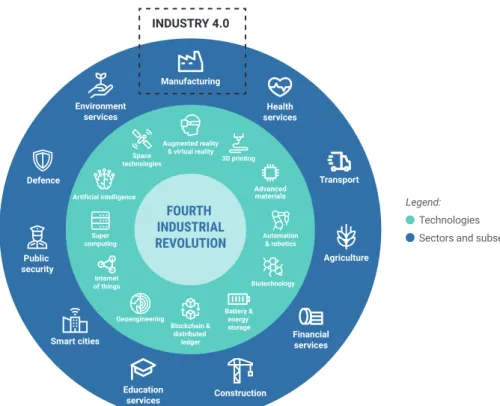
EVOLUTION OF TECHNOLOGIES
TECHNOLOGIES WITH PRESENCE IN MALAYSIA TECHNOLOGIES OF THE FUTURE
4IR comes in many forms, such as the digitally connected products and services people use, advances in smart cities and factories, and the increasing automation of tasks and services in the home and workplace. In addition, AI is also present in some sectors in Malaysia such as healthcare, retail and professional services.
DIGITAL
The digital economy is defined as economic and social activities involving the production and use of digital technologies by individuals, companies and authorities. 4IR implies an intensification of digital development across digital, physical and biological domains, as shown in Figure 1-5.
BIOLOGICALPHYSICAL
As digitization intensifies, which will enable more sophisticated technology applications, innovations and the emergence of new business models across all sectors, 4IR growth is accelerating.
RELATIONSHIP BETWEEN 4IR AND THE DIGITAL ECONOMY
The government has developed two guidance documents, namely the National 4IR Policy and the Malaysia Digital Economy Project to improve the country's readiness to harness the potential of 4IR and embrace the digital economy. The Malaysia Digital Economy Plan lays out the trajectory of the digital economy's contribution to the Malaysian economy and builds the foundation to drive digitization across the country, including bridging the digital divide.
THE NATIONAL 4IR POLICY AND
The national 4IR policy acts as a broad, overarching national policy to create coherence towards the nation's 4IR agenda and to deal with emerging risks from 4IR. This mechanism aims to increase clarity of focus areas as well as improve overall efficiency and accountability, which can ultimately facilitate change across the nation.
MALAYSIA DIGITAL ECONOMY BLUEPRINT
We need more for the country to keep up with the pace of change, especially in terms of technological progress, labor market demands, business model innovation and a changing public. The policy provides key guiding principles and strategic direction to ministries and agencies in formulating policies and action plans to optimize resource allocation.
Towards inclusive, balanced, responsible and sustainable
THE NATIONAL 4IR POLICY
Facilitates socioeconomic transformation through ethical use of 4IR technologies
MALAYSIA READINESS FOR 4IR
EMBRACING TECHNOLOGICAL ADVANCEMENT
Industry4WRD: National Policy on Industry A strategic guide to enable the transformation of the manufacturing sector and accelerate the adoption of Industry 4.0 related technologies. The National Fiberisation and Connectivity Plan (NFCP aims to deliver robust, pervasive, high-quality and affordable digital connectivity for the well-being of the rakyat and the progress of the country.
EXISTING POLICIES
The NFCP has been renamed as the Jalinan Digital Negara Plan (JENDELA) to provide wider coverage and better quality broadband to the rakyat while preparing the country for 5G technology. These demonstrate an urgent need for Malaysia to harness the benefits of 4IR in accelerating competitive advantage for societal progress.
A NEED TO ELEVATE COMPETITIVENESS
Malaysia's performance on the Economic Complexity Index over the past 15 years shows a declining competitive advantage over its regional competitors. Malaysia along with 24 other countries were categorized as leading countries in the WEF report, as shown in Figure 2-4.
LEVERAGING EXISTING STRENGTHS
Despite declining performance in several global competitiveness indices, Malaysia still maintains an above-average position in key technology and innovation-related global indices as reported in the WEF Readiness for the Future of Production Report 2018 and the International Telecommunication Union (ITU) Global Cybersecurity Index 2018. Malaysia is poised to position itself strongly in the future by increasing its readiness to adapt, exercising flexibility in dealing with the coming rapid pace and scale of change and increasing competitiveness in its areas of strength .
STRUCTURE OF PRODUCTION
According to the World Bank in the World Development Report 2016: Digital Dividends, Malaysia is on par with high-income countries in terms of the quality of complements5 and technologies. These rankings show that Malaysia's digital journey has provided a strong foundation for the nation to capture growth opportunities and mitigate risks emerging from the 4IR.
GEARING UP FOR 4IR
BUSINESSES
SOCIETY
MALAYSIA AND 4IR
Malaysia was also among 16 groups of upper-middle-income economies that scored highly on the Online Service Index (OSI) and moved from "high" to Systems and processes in the public sector need greater automation to enable real-time responses.
GLOBAL SHOCK
In the UN E-Government Survey 2020, Malaysia improved its position to 47th in the E-Government Development Index (EGDI), up from 60th in 2016. Meanwhile, in the ITU Global Cybersecurity Index 2018, Malaysia ranked 8th place worldwide and 2nd in Asia. -Pacific, demonstrating that extensive security controls are in place to secure data and prevent unauthorized access to the digital infrastructure.
CASE FOR CHANGE
Society needs an innovation-led mindset
Talent needs to be 4IR-ready to address current and future demands
To encourage service providers to develop the necessary infrastructure, investment costs must be lowered to increase returns. The capacity to deliver services needs to be enhanced through the provision of appropriate basic hardware and digital infrastructure enabling secure connectivity.
Affordable and high quality 4IR-enabling digital infrastructure needs to be easily accessed
Coherent regulations and shared accountability are necessary to persistently pursue effective change
NATIONAL 4IR POLICY
The 4IR National Policy adopts a human-centered approach to improve the well-being of the rakyat. The 4IR National Policy emphasizes the well-being of the rakyat as the main objective in this era of technology-enabled growth, especially in the realization of Wawasan Kemakmuran Bersama 2030 (WKB 2030).
NATIONAL 4IR POLICY APPROACH
The National 4IR policy takes into account resource optimization and implementation coordination of other related policies. This figure highlights improvements to existing initiatives as well as other key features unique to the National 4IR Policy.
ENSURING
The National 4IR Policy serves as a national framework to align government policy responses to unlock the potential socio-economic benefits and manage the risks arising from the 4IR. The National 4IR policy is an overarching policy to which other sector and technology-specific policies must be aligned.
COHERENT READINESS TO EMBRACE 4IR
Examples of new initiatives in four focus areas under the National 4IR policy, namely human capital, infrastructure, regulations and innovation, are shown in Figure 3-2. 41 Figure 3-2 : Highlights of new and improved initiatives in the National 4IR policy based on the four policy areas.
Focus areas Human capital
Technology adoption and
Malaysia has invested significant resources to cope with the technological changes and has laid the foundation for 4IR through rapid digitization. The national 4IR policy will put Malaysia in a strong competitive position for decades to come and will continue to improve the country's economic, social and environmental well-being.
NATIONAL AGENDA
SHARED PROSPERITY VISION 2030
MISSIONS
VISION
VISION FOR THE FUTURE
ECOLOGICAL INTERGRITYTO ACHIEVE BY 2030
Support the delivery of the national agenda, including the strategic direction set out in WKB 2030, as well as the country's commitment to the SDGs. Provides guidelines to address risks arising from 4IR technology adoption while preserving values and culture.
OBJECTIVES
POLICY THRUSTS
STRATEGIES
NATIONAL INITIATIVES
KEY SECTORS
SECTORAL INITIATIVES
FOUNDATIONAL TECHNOLOGIES
THE NATIONAL 4IR POLICY OVERVIEW
BUSINESSES SOCIETY
BALANCED, RESPONSIBLE AND SUSTAINABLE GROWTH
FOUNDATIONAL TECHNOLOGIESKEY SECTORS*
BENEFICIARIES
Private sector actors need to invest in innovation and embrace digital solutions and take the lead in several 4IR national policy initiatives. The growth and sustainable development of the private sector can then emphasize its important participation in the community and socio-economic development agenda.
STRATEGIC POLICY THRUSTS AND INITIATIVES
4 Policy Thrusts, 16 Strategies and 32 National Initiatives
POLICY THURSTS
THE NATIONAL 4IR POLICY TO GEAR UP MALAYSIA FOR THE 4IR
POLICY THRUST 01
Equip the rakyat with 4IR knowledge and skill sets
POLICY THRUST
Future-proof regulations to be agile with technological changes
Accelerate 4IR technology innovation and adoption
In addition to the national-level initiatives, the National 4IR Policy outlines sector-specific initiatives to capture opportunities arising from global and regional trends. Launch of new products and services as well as 4IR enabled business models through 4IR technologies Integration with the global value chain.
SUPPORTING SECTORS
The selection of key focus sectors is based on their contribution to GDP, as well as their role in influencing the growth of other sectors. In line with the thrusts of the 4IR national policy, sector-specific initiatives in the top 10 sectors are grouped under four common themes, viz.
HUMAN CAPITAL DEVELOPMENT
INFRASTRUCTURE IMPROVEMENT
REGULATIONS IMPROVEMENT
TECHNOLOGY ADOPTION AND INNOVATION
Increase the robustness of the regulatory framework to support the adoption of 4IR technologies related to transport and logistics. Increase mobility through the development and adoption of a centralized and open transport-related database, including traffic management. Support R&D&C&I for 4IR technologies to develop low-carbon mobility solutions.
Transportation and logistics
Wholesale and retail trade
Finance and insurance
Tourism
Professional, scientific and technical services
Utilities
Education
Manufacturing
Healthcare
Agriculture
Although the 4IR national policy emphasizes 10 key sectors, it is important to note that the convergence in the 4IR is characterized by the fusion of technologies and the increasing integration of different sectors. The intensification of digitization in various fields will change the interactions of various entities in the future and blur the traditional boundaries between industries.
INDUSTRIES
New business models and industries are expected to emerge as the boundaries between suppliers, producers and consumers and, in some cases, within entire industries shift.
OF THE FUTURE
It is also estimated that global GDP will increase by an additional USD 15.7 trillion in 2030; and could increase GDP in the developed Asian region (excluding China) by 10.4%5. IoT is also being actively promoted in the agricultural sector to modernize farming and improve the overall efficiency and productivity of the sector.
FOUNDATIONAL 4IR TECHNOLOGIES
Initiatives such as the development of a national AI framework and an AI park signal the country's commitment to increasing AI adoption in Malaysia. In Malaysia, there is increasing interest in the application of blockchain technologies in various sectors such as the food and beverage industry and the financial sector.
IMPLEMENTATION OF NATIONAL INITIATIVES UNDER THE NATIONAL 4IR POLICY
ENHANCE 4IR AWARENESS AND ADOPTION
Adopt agile regulatory approach to meet the needs of the digital economy businesses Initiative 26: Allow real time matching, provide coordinated support and facilitation to accelerate innovation
Incentivise 4IR technology applications for business improvement (performance-linked incentives) Initiative 28: Mobilise co-investment fund for 4IR technology adoption by industries
Enhance and implement PAK-21 in all public schools to develop humanistic soft skills for future workforce to be 4IR-ready
Enhance 4IR-related courses in higher education institutions (HEIs) and technical and vocational education and training (TVET) institutions through better programme design and delivery
Rationalise and enhance collaboration to ensure equal access to 4IR learning opportunities for all Initiative 10: Enhance formal social protection mechanism for gig workers
Introduce a 4IR Innovation Accelerator, dedicated to driving adoption of 4IR technologies in public sector at all levels of government
Provide 4IR-related training to all civil servants
Expand the MyGovCloud to promote cloud computing environment in the public sector Initiative 18: Enhance workforce mobility of the public sector
DRIVE TRANSFORMATION AND INCLUSIVITY OF 4IR
Establish 4IR innovation parks with 4IR application centres to provide a secure test-bed for
Expand digital marketplace for the digitally underserved rural community to bridge the technology adoption gap
Introduce specific legislation on cyber security Initiative 22: Enhance personal data protection law, regulations
Drive greater adoption of 4IR technologies within the government services with the National Digital
Establish Government Experience Lab to drive 4IR innovation
Provide support to innovative businesses and social enterprises to leverage 4IR
Prioritise public sector R&D&C&I funding for technology innovations
Co-create and co-design 4IR-related policies and regulations via a rakyat-centric approach
ACHIEVE BALANCED, RESPONSIBLE AND SUSTAINABLE GROWTH BY
GOVERNANCE STRUCTURE
The 4IR National Policy and Malaysia's Digital Economy Project complement each other towards achieving comprehensive, balanced, responsible and sustainable action. Therefore, the implementation of the 4IR National Policy will also be governed by the same governance structure that governs the Project.
OPTIMISING COORDINATION
Strong collaboration between ministries and agencies is required as some initiatives under this Policy and the Blueprint involve multiple entities with relevant portfolios. This governance structure will inculcate shared responsibilities and improve overall efficiency, accountability and public-private partnership.
Thematic cluster
Policy Thrust1
- National Digital Economy and 4IR Council provides leadership and policy direction
- Clusters provide expert and technical support for policy development and direction
- Steering Committee functions to coordinate and monitor effective implementation
- Strategic Change Management Office functions as the (i) change management driver, (ii) overall
- Working Groups act as lead implementers of the initiatives and provide technical expertise
The Strategic Change Management Office functions as (i) change management driver, (ii) overall as (i) change management driver, (ii) overall monitoring and evaluation unit and (iii) secretariat for the National Digital Economy and 4IR Council and Steering committee. Working groups act as lead initiators of the initiatives and deliver technical expertise initiatives and provide technical expertise. The governance structure is as shown in Figure 4-2.
National Digital Economy and 4IR Council chaired by the Prime Minister
CONCLUSION
The National 4IR Policy sets the direction for exploiting the potential of 4IR technologies and addressing potential risks. The 4IR National Policy outlines three objectives, four policy directions and is supported by 16 strategies to prepare the country to adopt 4IR and deal with current and future disruptions from emerging technologies.
60 SECTORAL INITIATIVES
In addition to opportunities for the sustainable growth of countries, 4IR also presents risks that need to be mitigated. National and sectoral initiatives aim to increase local capacity in exploiting the growth opportunities arising from the 4IRs, increase the conservation of ecological integrity and improve the quality of life of the rakyat.

